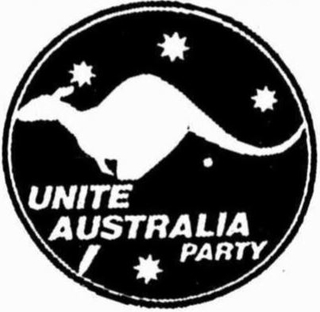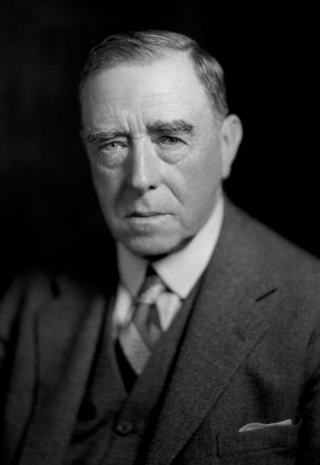
The United Australia Party (UAP) was an Australian political party that was founded in 1931 and dissolved in 1945. The party won four federal elections in that time, usually governing in coalition with the Country Party. It provided two prime ministers: Joseph Lyons (1932–1939) and Robert Menzies (1939–1941).

The Nationalist Party, also known as the National Party, was an Australian political party. It was formed in February 1917 from a merger between the Liberal Party and the National Labor Party, the latter formed by Prime Minister Billy Hughes and his supporters after the 1916 Labor Party split over World War I conscription. The Nationalist Party was established as a 'united' non-Labor opposition that had remained a political trend once the Labor party established itself in federal politics. The party was in government until electoral defeat in 1929. From that time it was the main opposition to the Labor Party until it merged with pro-Joseph Lyons Labor defectors to form the United Australia Party (UAP) in 1931. The party is a direct ancestor of the Liberal Party of Australia, the main centre-right party in Australia.

The Unite Australia Party (UAP) was a short-lived Australian political party that existed in the late 1980s.

The 1943 Australian federal election was held in Australia on 21 August 1943. All 74 seats in the House of Representatives and 19 of the 36 seats in the Senate were up for election. The incumbent Labor Party, led by Prime Minister John Curtin, defeated the opposition Country–UAP coalition led by Arthur Fadden in a landslide.

The 1931 Australian federal election was held on 19 December 1931. All 75 seats in the House of Representatives and 18 of the 36 seats in the Senate were up for election.
The Liberal Democratic Party (LDP) was an Australian breakaway political party of the United Australia Party that contested the 1943 federal election and the 1944 New South Wales state election. Formed in 1943, it was replaced by the New South Wales division of the Liberal Party of Australia in January 1945.
This is a list of the members of the Australian House of Representatives in the 17th Australian Parliament, which was elected at the 1943 election on 21 August 1943. The incumbent Australian Labor Party led by Prime Minister of Australia John Curtin defeated the opposition Country Party led by Arthur Fadden with coalition partner the United Australia Party (UAP) led by Billy Hughes. On 21 February 1945, the parliamentary UAP was dissolved and replaced by the newly established Liberal Party.
This is a list of the members of the Australian House of Representatives in the 13th Australian Parliament, which was elected at the 1931 election on 19 December 1931. The incumbent Australian Labor Party led by Prime Minister of Australia James Scullin was defeated by the newly formed opposition United Australia Party led by ex-Labor Joseph Lyons with coalition partner the Country Party led by Earle Page.
This is a list of members of the Australian Senate from 1935 to 1938. Half of its members were elected at the 19 December 1931 election and had terms starting on 1 July 1932 and finishing on 30 June 1938; the other half were elected at the 15 September 1934 election and had terms starting on 1 July 1935 and finishing on 30 June 1941. The process for filling casual vacancies was complex. While senators were elected for a six-year term, people appointed to a casual vacancy only held office until the earlier of the next election for the House of Representatives or the Senate.
This is a list of members of the Australian Senate from 1932 to 1935. Half of its members were elected at the 17 November 1928 election and had terms starting on 1 July 1929 and finishing on 30 June 1935; the other half were elected at the 19 December 1931 election and had terms starting on 1 July 1932 and finishing on 30 June 1938. The process for filling casual vacancies was complex. While senators were elected for a six-year term, people appointed to a casual vacancy only held office until the earlier of the next election for the House of Representatives or the Senate.
This is a list of members of the Australian Senate from 1929 to 1932. Half of its members were elected at the 14 November 1925 election and had terms starting on 1 July 1926 and finishing on 30 June 1932; the other half were elected at the 17 November 1928 election and had terms starting on 1 July 1929 and finishing on 30 June 1935. The process for filling casual vacancies was complex. While senators were elected for a six-year term, people appointed to a casual vacancy only held office until the earlier of the next election for the House of Representatives or the Senate.
Members of the New South Wales Legislative Assembly who served in the 32nd parliament held their seats from 1938 to 1941. They were elected at the 1938 state election, and at by-elections. The Speaker was Reginald Weaver.

The 1941 New South Wales state election was held on 10 May 1941. This election was for all of the 90 seats in the 33rd New South Wales Legislative Assembly and was conducted in single-member constituencies with compulsory preferential voting.
The Democratic Party was a short-lived, urban, conservative political party which was active in New South Wales, Australia between November 1943 and 1945. The Democratic Party was formed in November 1943 by the union of the United Australia Party (UAP) in New South Wales and the Commonwealth Party. It was one of the main conservative parties in New South Wales and contested the 1944 state election as a coalition with Country Party.
The Commonwealth Party was a short-lived, urban, conservative political party in New South Wales between May 1943 and January 1944.

The 1944 New South Wales state election was held on 27 May 1944. It was conducted in single member constituencies with compulsory preferential voting and was held on boundaries created at a 1940 redistribution. The election was for all of the 90 seats in the Legislative Assembly.

The 1940 Victorian state election was held in the Australian state of Victoria on Saturday 16 March 1940 to elect 44 of the 65 members of the state's Legislative Assembly.

The 1935 Victorian state election was held in the Australian state of Victoria on Saturday 2 March 1935 to elect 53 of the 65 members of the state's Legislative Assembly. 12 seats were uncontested.

The United Australia Party (UAP), formerly known as Clive Palmer's United Australia Party and the Palmer United Party (PUP), is an Australian political party formed by mining magnate Clive Palmer in April 2013. The party was deregistered by the Australian Electoral Commission in 2017, revived and re-registered in 2018, and voluntarily deregistered in 2022. The party fielded candidates in all 150 House of Representatives seats at the 2013 federal election. Palmer, the party's leader, was elected to the Division of Fairfax and it reached a peak of three senators following the rerun of the Western Australian senate election in 2014. When the party was revived under its original name in 2018, it was represented by ex-One Nation senator Brian Burston in the federal parliament.

The Australian Labor Party split of 1931 was caused by severe divisions within the Australian Labor Party (ALP) over its economic response to the Great Depression. Amidst intense disagreement between economically conservative and radical elements of the party, two senior ministers in the Scullin Labor government, Joseph Lyons and James Fenton, resigned from Cabinet in January 1931. Lyons, Fenton and their supporters would subsequently merge with the conservative opposition Nationalist Party to form the new United Australia Party (UAP), led by Lyons with the last Nationalist leader, John Latham, as his deputy.











